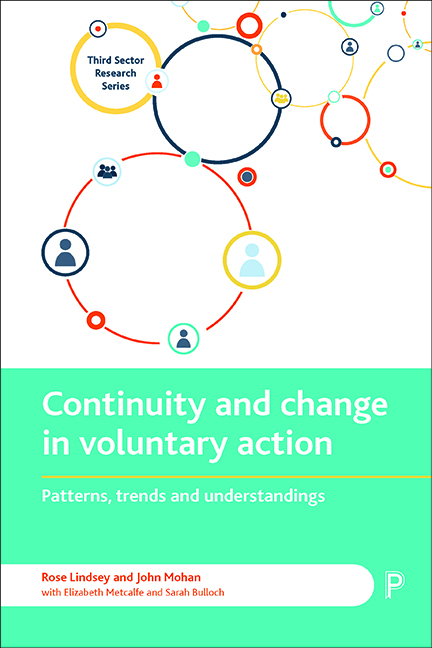Book contents
- Frontmatter
- Contents
- List of figures and tables
- Foreword
- Acknowledgements
- Notes on authors
- Acronyms
- one Introduction
- two The changing policy environment for voluntary action from 1979
- three Data: sources and definitions
- four Trends in volunteering and trends in the voluntary sector
- five Content and context of volunteering
- six Why people volunteer: contextualising motivation
- seven Volunteering trajectories: individual patterns of volunteering over the lifecourse
- eight Attitudes to voluntary action
- nine Conclusions
- Appendix: Anonymised details of writers
- References
- Index
five - Content and context of volunteering
Published online by Cambridge University Press: 13 April 2022
- Frontmatter
- Contents
- List of figures and tables
- Foreword
- Acknowledgements
- Notes on authors
- Acronyms
- one Introduction
- two The changing policy environment for voluntary action from 1979
- three Data: sources and definitions
- four Trends in volunteering and trends in the voluntary sector
- five Content and context of volunteering
- six Why people volunteer: contextualising motivation
- seven Volunteering trajectories: individual patterns of volunteering over the lifecourse
- eight Attitudes to voluntary action
- nine Conclusions
- Appendix: Anonymised details of writers
- References
- Index
Summary
Introduction
In the previous chapter, the focus was on levels of voluntary action, as revealed by social surveys, and the extent to which individuals’ reports of their engagement do, or do not, conform to the quantitative portrait. Here we go into much more depth as to exactly what it is that individuals do when they volunteer.
We do so, first through analysing social surveys which have asked respondents about the content of their activities – namely, what sorts of organisations they help, the activities they carry out and the roles they play, regardless of whether the activity takes place in organisational settings, or informally in the community. The surveys provide information about the type of groups to which individuals give help (for example, health and social care, sports, religious organisations), the type of help provided (for example, raising money, mentoring, providing transport), and the sorts of informal activities in which individuals engage in their communities (for example, visiting elderly people, home decorating, car repairs). Despite some variation in the approaches taken by various surveys, we provide a broad overview of these activities, and demonstrate whether these have changed over time (for example, have certain forms of activity become more or less prominent?). The measures we use are simply whether or not respondents were involved in particular activities; generally the surveys used do not permit quantification of the volume of effort contributed (for example, time spent), nor apportionment by field of activity. However, the information available on hours committed to formal and informal volunteering in the Citizenship Survey (CS) does allow us to make brief reference to arguments concerning a British ‘civic core’ – a small subset of the population which accounts for the bulk of voluntary effort.
We then provide an extended discussion of material provided by the Mass Observation Project (MOP) writers in relation to the content of their voluntary activities, and where possible, their context – that is, how those activities came about. We emphasise this, because a key point made in the volunteering literature is the importance of being asked to engage (Musick and Wilson, 2008, chapter 13).
- Type
- Chapter
- Information
- Continuity and Change in Voluntary ActionPatterns, Trends and Understandings, pp. 85 - 112Publisher: Bristol University PressPrint publication year: 2018



